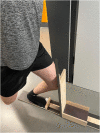Influence of Long-Lasting Static Stretching on Maximal Strength, Muscle Thickness and Flexibility
- PMID: 35694390
- PMCID: PMC9174468
- DOI: 10.3389/fphys.2022.878955
Influence of Long-Lasting Static Stretching on Maximal Strength, Muscle Thickness and Flexibility
Abstract
Background: In animal studies long-term stretching interventions up to several hours per day have shown large increases in muscle mass as well as maximal strength. The aim of this study was to investigate the effects of a long-term stretching on maximal strength, muscle cross sectional area (MCSA) and range of motion (ROM) in humans. Methods: 52 subjects were divided into an Intervention group (IG, n = 27) and a control group (CG, n = 25). IG stretched the plantar flexors for one hour per day for six weeks using an orthosis. Stretching was performed on one leg only to investigate the contralateral force transfer. Maximal isometric strength (MIS) and 1RM were both measured in extended knee joint. Furthermore, we investigated the MCSA of IG in the lateral head of the gastrocnemius (LG) using sonography. Additionally, ROM in the upper ankle was investigated via the functional "knee to wall stretch" test (KtW) and a goniometer device on the orthosis. A two-way ANOVA was performed in data analysis, using the Scheffé Test as post-hoc test. Results: There were high time-effects (p = 0.003, ƞ² = 0.090) and high interaction-effect (p < 0.001, ƞ²=0.387) for MIS and also high time-effects (p < 0.001, ƞ²=0.193) and interaction-effects (p < 0.001, ƞ²=0,362) for 1RM testing. Furthermore, we measured a significant increase of 15.2% in MCSA of LG with high time-effect (p < 0.001, ƞ²=0.545) and high interaction-effect (p=0.015, ƞ²=0.406). In ROM we found in both tests significant increases up to 27.3% with moderate time-effect (p < 0.001, ƞ²=0.129) and high interaction-effect (p < 0.001, ƞ²=0.199). Additionally, we measured significant contralateral force transfers in maximal strength tests of 11.4% (p < 0.001) in 1RM test and 1.4% (p=0.462) in MIS test. Overall, there we no significant effects in control situations for any parameter (CG and non-intervened leg of IG). Discussion: We hypothesize stretching-induced muscle damage comparable to effects of mechanical load of strength training, that led to hypertrophy and thus to an increase in maximal strength. Increases in ROM could be attributed to longitudinal hypertrophy effects, e.g., increase in serial sarcomeres. Measured cross-education effects could be explained by central neural adaptations due to stimulation of the stretched muscles.
Keywords: hypertrophy; maximal strength; muscle cross sectional area; range of motion; static stretching.
Copyright © 2022 Warneke, Brinkmann, Hillebrecht and Schiemann.
Conflict of interest statement
The authors declare that the research was conducted in the absence of any commercial or financial relationships that could be construed as a potential conflict of interest.
Figures







References
LinkOut - more resources
Full Text Sources

